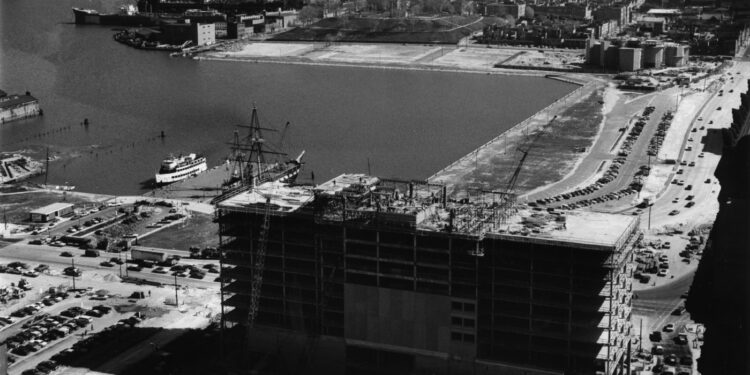
Baltimore needed an upbeat Thanksgiving in 1974. Inflation was kicking up prices. Chesapeake Bay watermen went on strike over low oyster prices. Memories lingered of the recent oil embargo and long lines at gas pumps. Richard Nixon had resigned his presidency only three months earlier. People didn’t know what to expect from President Gerald Ford.
Times were not golden. The Salvation Army reported an increase in persons seeking a hot meal that year.
Baltimore was in a time of flux. The Inner Harbor, which would come of age with the arrival of the Tall Ships in 1976 and the opening of Harborplace in 1980, was still a muddy construction and demolition zone. Within a year, Morris A. Mechanic Theatre would close because of poor attendance.
Old traditions lingered but with decreasing enthusiasm.
The Toy Town Parade sponsored by the Hochschild Kohn department store was no more. But Mayor William Donald Schaefer ordered that the holiday season would be marked in downtown Baltimore, despite naysayers and gloomy economists.
He drafted carolers from high schools and churches. Singers from Western, Lake Clifton, Frederick Douglass, and Walbrook were joined by ensembles from Armistead Gardens, Saint Elizabeth of Hungary parish and the Patterson Clipper Choir, to sing their hearts out along Lexington Street that 1974 season.
The mayor also orchestrated stepped-up outdoor decorations downtown, a tradition that seemed to have fallen away in the 1960s.
Baltimore still had four big department stores at the corner of Howard and Lexington streets. They had animated Christmas windows which traditionally were under wraps until Thanksgiving morning when curtains were pulled back for the annual display.
Bells from downtown churches — the Basilica of the Assumption, St. Alphonsus and Zion Lutheran — rang out at noon.
As much as Schaefer tried to put a good face on downtown Baltimore’s holiday show that year, there were signs the old department stores were in financial trouble. Hochschild’s would close downtown in 1977 and Stewart’s in 1979.
But there was a newfound vitality happening elsewhere — in a then blue-collar but spirited neighborhood. The year before, Hampden merchants and residents had established a Mayor’s Christmas Parade for the holidays and vowed it would be a reality in 1974. They were as good as their word, too.
Bands, floats and politicians in Cadillacs filled Falls Road and 36th Street. Shopkeepers decorated windows for the holiday season. The New System Bakery had fruitcake and pumpkin pies.
Over the years Hampden’s holiday spirit has not shown any sign of deteriorating. A decade later, residents along 34th Street would start an annual tradition of free-spirited, coordinated decoration and lights.
Baltimore still had its beloved Colts in 1974. Bert Jones was slated to quarterback for the Colts the following Sunday in a game against the Buffalo Bills. The old stadium was still the place to buy a fresh Christmas tree sold by veterans to benefit the Eye Bank of Maryland.
There were no backups reported on the Bay Bridge. The Harbor Tunnel experienced somewhat heavier traffic and Amtrak reported packed trains.
The annual high school football rivalries continued at the old Memorial Stadium.
Calvert Hall coach Augie Miceli said of his school’s loss to Loyola High School, “We’ve had more than our share of bad breaks this season, but nothing like this.”
Loyola defeated Calvert Hall, 40 to 28, with the Dons’ Pete Legler and Mark Poehlman earning sports writers’ kudos.
What was on television? NBC screened “The Godfather Part II” and that swept the ratings for the middle of November. Other top shows that month included “All in the Family,” “A Charlie Brown Special,” “The Waltons,” “M.A.S.H.”, “Mary Tyler Moore,” “Bob Newhart,” “Good Times,” “Kojak” and “Mannix.”
James Bond films remained popular. “The Man with the Golden Arm” arrived in Baltimore that Thanksgiving. The film starred Roger Moore, Christopher Lee and Britt Ekland. Also released was Agatha Christie’s “Murder on the Orient Express,” which would arrive in Baltimore some weeks later. It starred Albert Finney as detective Hercule Poirot. The Evening Sun’s Lou Cedrone reported the film, which opened at the Pikes, Hillendale and Westview, “is doing exceptional and deserved business.”
The Lexington Market had a busy November. Lines formed at Rheb’s candies as clerks sorted out special requests for vanilla creams and almond clusters. There was a demand for fresh ground coconut and horseradish. Poultry dealers did a good trade.
Baltimore was intrigued by the concept of urban homesteading. There were news reports that November that a large section off South Charles and South Hanover streets would be the next “dollar house” renovation area. It was named Otterbein and before long urban pioneers and their contractors descended enthusiastically on the area.






